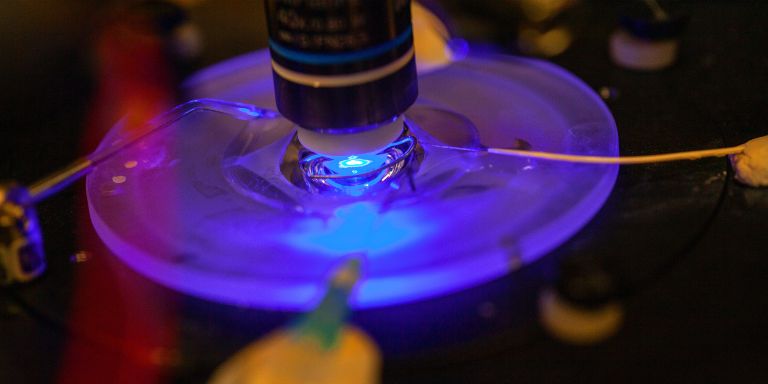
Emanuela Santini
PhD Medicine and Health Science
Wallenberg Academy Fellow 2017
Institution:
Karolinska Institutet
Research field:
What causes repetitive behaviors in autism?


Wallenberg Academy Fellow 2017
Institution:
Karolinska Institutet
Research field:
What causes repetitive behaviors in autism?
Santini is waiting in the reception area, and leads the way through three security doors and gates before we reach her office at the Department of Neuroscience at Biomedicum, Karolinska Institutet (KI) in Solna, just north of Stockholm. The mezzanine design extending several floors up to the roof, and generous glass walls lend an open and spacious feel to the building.
Santini enthusiastically explains how the transparency of the architecture facilitates meetings across departmental boundaries:
“It can be hard for researchers to collaborate, but there are no walls here. It’s stimulating to be with people without any physical obstacles in the way. We speak a language that knows no bounds.”
Being chosen as a Wallenberg Academy Fellow persuaded Santini to leave the U.S. to establish a research team at KI. Since summer 2018 she and her fellow researchers have been trying to understand what causes repetitive behaviors in children with an autism spectrum diagnosis.
Autism is a functional disorder that is congenital or acquired early, appearing before the age of three. Symptoms include communication difficulties and a disinclination to play with other children.
Some people with autism repeat the same sound or movement over and over again. It is quite common for them to walk on tiptoe or harm themselves by banging their head against a wall.
Few studies have examined the cause of the disorder, and how it should be treated.
Santini’s team is studying molecular causes of changes in the synapses between neurons in the part of the brain that controls volitional movements.
“We believe the behavior is due to an uncontrollable production of proteins that regulate synaptic plasticity,” Santini explains.
Studies have shown that several genetic mutations, including eIF4E, can result in various forms of autism spectrum disorder. The research team is now studying how mice with the same mutation behave.
“The functional impairment can be recreated in mice, enabling us to study both their behavior and processes in their brains.”
Mice with autism may also repeat the same movements again and again. They rub their fur off around their snouts or compulsively burrow.
They also lack the ability to make new decisions. If the transgenic mice have learnt to find an escape route between two cages and the route is blocked off, they are unable to work out an alternative solution.
“Humans with autism also find it difficult to change their patterns of behavior. If they are used to parking their car in a certain place, and that place is occupied, they may become paralyzed – unable to look for another parking place.”
Nor are the transgenic mice particularly sociable. Given the choice between a cage with a toy in it and one containing another mouse, they usually prefer the toy.
“If we can translate the findings from animal-based studies to humans, we may find common molecular patterns that help us to make a diagnosis and develop drugs. At the moment we are trying to ascertain the region of the brain involved, and look for the protein that codes for certain behaviors.”
“I wanted to move to become more independent as an individual, and also as a researcher. I needed to develop both a personal and an intellectual strength.”
Santini was born and raised in Rome, where she studied biology for her first degree. While working on her Master’s in Neurobiology, she made a study visit to a professor who had a laboratory at KI.
Straight away she felt at home in the working environment, and accepted a doctoral position:
“I also fell in love with Stockholm – the light, the dynamic skies, the clouds scudding swiftly by, and the slow sunset. It can take two hours for the sun to go down. And the snow! The evenings are dark, but everyone lights candles in their windows when they’re home. I’d never experienced such contrasts between the seasons.”
The subject of her doctoral thesis was the molecular mechanisms in the brain’s signal system in Parkinson’s sufferers, who, like children with autism, can experience involuntary movement patterns. Much of what she learnt then is of use in her current research.
During her years at KI she met her husband, who accompanied her to the U.S., where she took up a postdoctoral position at the Center for Neuroscience at New York University.
“I had an exceptionally gifted supervisor, who gave me enormous freedom, and allowed me to grow as a researcher. The balance between supervision and freedom suited me.”
A “K99 Pathway to Independence Award” from the National Institutes of Health enabled her to establish her own laboratory at Columbia University, where she remained for two years.
“We liked living in the U.S., but we had two children by that time, and we began to consider returning to Europe. I felt that I owed an intellectual debt to Sweden. It was here that I started my research career. I would never have been able to do so in Italy.”
Now she sits in her office, back to back with her husband, who also heads a research team at KI, and prepares a presentation for the KI Pediatric Unit.
“I hope I can find a clinician who wants to collaborate with me. I think researchers should talk more to each other – try to get others interested in what they are doing. Here and now is the right place and time to do so.”
Text Carin Mannberg-Zackari
Translation Maxwell Arding
Photo Magnus Bergström